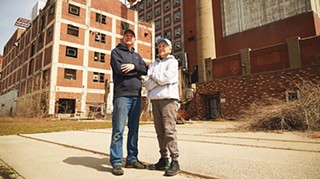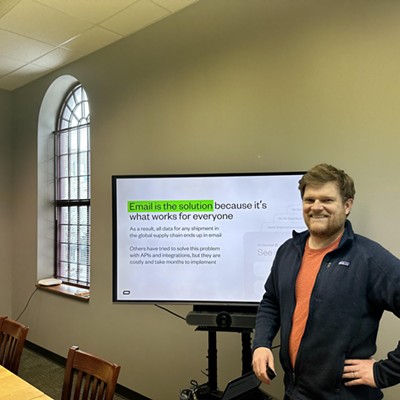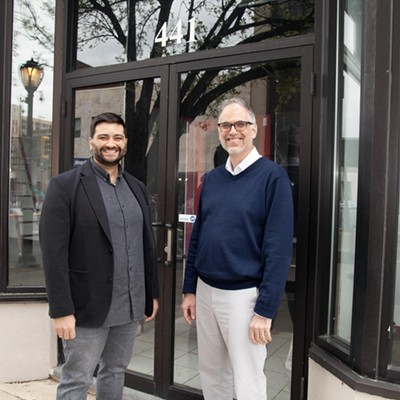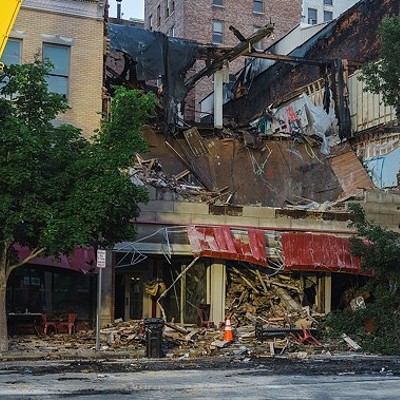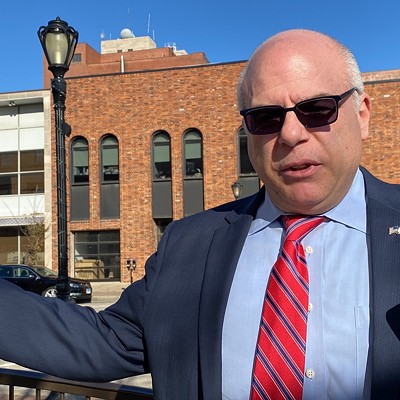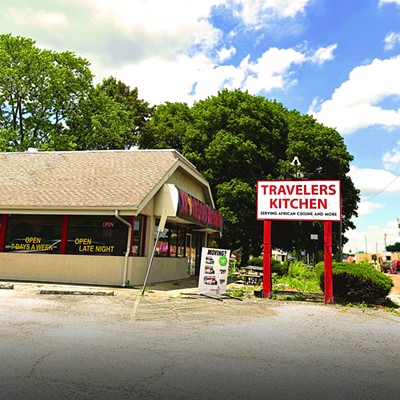Engineering the future: moving Springfield forward
The work of Moving Pillsbury Forward, the nonprofit created to take ownership of the former Pillsbury flour mill complex at 1525 E Phillips St., is to prepare for environmental cleanup and future redevelopment and is key to the story of the biggest engineering project in Springfield, spanning more than a century.
It's a startling fact that in 1929, as the nation faced a stock market crash that would result in severe economic downturn and long before we knew of wheat-gluten allergy, one of the country's most important industries was planting its roots in Illinois' capital city with an eye to building a breadbasket for the world.
The progressive Minneapolis-based Pillsbury Company developed a shining engineering achievement in Springfield, with its two massive flour mills working in tandem, as well as a grocery-baking operation. A third flour mill was added in 1938, later enlarged with post-WWII steel-frame construction, expanding the plant's bakery mix facility, fashioned from 30,000 tons of concrete. According to Chris Richmond, the retired Springfield fire marshal who has been coordinating the work of MPF, by the 1940s the plant would eventually grow to cover 18 acres, consuming more than 50% of the power generated by City Water, Light and Power.
As Richmond explained, "Pillsbury was to become an economic juggernaut, supporting and sustaining community growth." With 800,000 square feet of multistory buildings, some erected with locally manufactured materials from Springfield's Poston Brick Company, the plant was bisected by rail tracks that supplied thousands of bushels of grain to be unloaded at the head house, where it was weighed and stored in silos soaring above the factory buildings.
Pillsbury's local workforce swelled from 300 to 850 during the years of the Great Depression, and the post-WWII baby boom sent markets soaring. By 1955, the number of workers at the plant peaked at 1,500 employees working in three shifts, Richmond told a sizable crowd who attended one of several public tours MPF offered during the past year.
At its height, Pillsbury was a source of community pride producing specialty flours, baking products, fragrant snacks, brownie and cake mixes that were loaded onto rail cars and tractor-trailers daily as they made their way to fill America's grocery store shelves. Families of former employees and neighborhood residents shared stories of how rows of trucks hauling wagons filled with grain would park along 15th Street and wait their turn to unload. Drivers made the most of this time by enjoying lunch from sandwich carts owned and operated by local entrepreneurs.
The 1960s saw the number of silos at the Pillsbury mills complex increase to 160, providing capacity to hold 3 million bushels of grain, the concrete exteriors painted with the latest invention to abate combustion – asbestos paint. During the next three decades, mechanical engineering innovations such as the forklift and pallet would streamline operations and expand production at Pillsbury while the need for manpower would decline.
By 1991, in spite of Pillsbury setting milling production records, its status as a hub of agriculture commerce would forever change. The company's workforce was reduced to 450, and Cargill, an American global food corporation, purchased Pillsbury Company and eventually closed the grocery and bakery divisions. This move would permanently halt operations at Springfield's one-time premiere food production business in 2001. Cargill then reduced the plant to a grain storage facility, and in 2008 sold the abandoned behemoth for scrap.
Recognizing the impact of Pillsbury's vacant, mammoth footprint on the surrounding neighborhood and community at large, experts came together in 2005 for a mini-design charrette to generate ideas. The public brainstorming sessions resulted in a report offering reuse strategies to deal with the former site that is now considered toxic brownfield land. Its crumbling structures are in need of demolition and environmental clean-up that carries an estimated price tag of $8 million.
With the city unwilling to step in due to liability concerns, the site languished in legal limbo for years until a core group of dedicated community volunteers, optimists and professionals decided that it wasn't acceptable for the industrial skeleton to continue to be a blight on the community. Hard-working citizen leaders like Richmond, whose father once worked at Pillsbury, and Polly Poskin, a longtime advocate for older neighborhoods, have succeeded in raising community awareness through public meetings, tours and outreach presentations, recently securing the financial support needed to ready the site for remediation and potential redevelopment.
Nearly a century after Springfield celebrated Pillsbury's grand opening, remediation efforts got underway to rid the 18-acre site of asbestos-contaminated elements, lead-based paint and other toxins found in the water and soil on the site. This work is being accomplished in part with grant funding from the U.S. Environmental Protection Agency and congressional funding through the U.S. Department of Housing and Urban Development, under the direction of Joel Zirkle of Fehr Graham, an Illinois-based engineering and environmental company, and Chapman Environmental Services, an integrated environmental management and consulting firm.
Adaptive reuse improves health care
Transforming the former Shop 'n Save grocery store at 206 North Grand Avenue W. into a state-of-the art simulation lab for students of Illinois State's Mennonite College of Nursing and the new headquarters for emergency medical services provider Medica First is an excellent example of adaptive reuse: the renovation and reuse of existing structures for a new purpose.
Repurposing the 55,000-square-foot space vacated by the grocery store provides support to the community in terms of increased access to health care, tax generation and employment opportunities in a well-established residential neighborhood.
Medics First occupies the 45,000 square feet on the east side of the renovated structure which has a refreshed and extended façade designed by O'Shea Builders, the general contractor for the project. Included is 25,000 square feet for vehicle storage, 4,500 square feet for office space, 4,000 square feet for living quarters and 11,500 square feet for future tenant buildout.
The west portion of the structure houses Illinois State's Mennonite College of Nursing, a combined effort with Memorial Health's hospital network that offers transfer students a traditional bachelor of science in nursing program. The 10,000-square-foot facility is broken down into classrooms, a lounge area with a kitchen, administrative offices and conference rooms, according to Bridget Ingebrigtsen, brand director for O'Shea Builders.
Due to an ongoing shortage of nurses, Memorial Health is investing in local nursing education to increase the supply of registered nurses needed to staff its five area locations in Taylorville, Decatur, Lincoln, Jacksonville and Springfield, according to Kevin England, senior vice president and chief administrative officer for Memorial Health. With an investment of $25 million in nursing education locally, Memorial Health hopes to graduate 500 BSN students who will continue to work in the region.
"When we started talking to ISU about forming a public-private partnership, this location close to the hospital and medical facilities was key to accessing clinical sites, where the Memorial system hosts 600 students per academic semester," said England. In addition, proximity to Medics First will allow students the bonus of learning about specialized advanced medical transport and potentially the ability to ride along on emergency calls.
The first cohort of 33 nursing students began classes at the new Springfield location in the fall of 2023. The facility is built to support a class size of 45 junior and 45 senior-level nursing students, according to Clint Smith, Springfield site administrator for Mennonite College of Nursing.
Students at the Springfield facility benefit from innovative tools such as virtual reality simulation labs where they use VR headsets to experience patient care in 3D. When students from the campus in Normal visit they are envious of this cutting-edge learning opportunity, said Smith.
A Green Family Stores automotive building boom Green Family Stores has built the largest Hyundai sales showroom in the 14 central Unites States region at 601 Stanford Ave. in Springfield, according to Time Nice, executive general manager. The previous Hyundai facility on South Dirksen Parkway will remain open as a dealership for used vehicles and a service center. In addition, Green Family Stores has locations on West Iles Avenue, West Wabash Avenue and South Sixth Street.
Indianapolis-based Custom Facilities Incorporated is the mega-design/construction company that built the Stanford Avenue facility. The company worked with Green to implement what is known in the auto industry as a Design Intent Document that specifies style and appearance criteria for buildings representing the Hyundai brand.
Custom Facilities Inc. has designed more than 500 dealerships nationwide, and is the expert in executing marketing and display concepts that the Original Equipment Manufacturers want to promote in each branded sales environment, according to Nice. The result is a grand showroom floor with 20-foot ceilings, lit by a south-facing wall of windows and second-floor mezzanine with office space.
The new Hyundai dealership is hard to miss with its massive 188,000 square feet of modern structural space combined with vehicle display area. "After 14 months – start to finish – in construction, our final D.I.D. compliance review approval is expected very soon," said Nice. "In addition to being the largest auto showroom in our community by far, there are features like large glass windows that allow customers to watch as their cars are in the service process," said Nice.
With an eye toward future growth in the battery electric vehicle market, the Green Hyundai location has state-of-the-art level three charging stations available for electric vehicle drivers, regardless of whether they purchased their cars from Green, said Nice.
Future plans for Green Family Stores include breaking ground for a new 25,000-square-foot Subaru sales facility across from the new Hyundai dealership. The building and relocation of Green's Subaru store is expected to be completed by mid-2025. Catherine O'Connor has held administrative, communications, education and advocacy roles in state government, regional and national organizations. Her work focuses on exploring social and cultural context, making our history and environment more accessible and relevant through storytelling.

